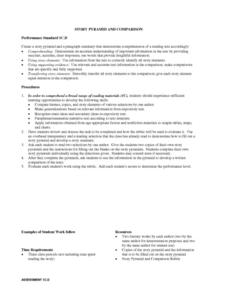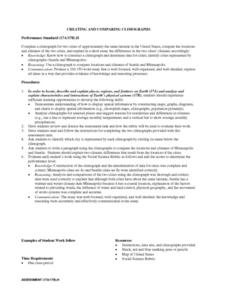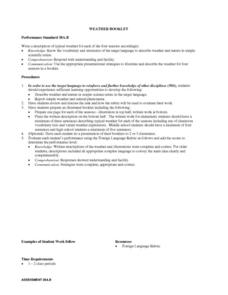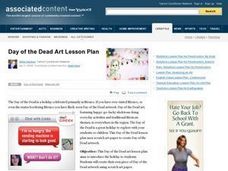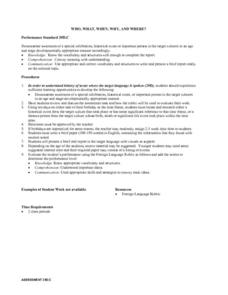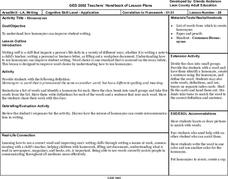Curated OER
Anticipatory Set Picture Walk
The teacher models a Picture Walk by using a "think aloud" method while reading a picture book to the class. On the second day, 3rd graders use a worksheet as a guide for a second picture walk. This time, students complete the "think...
Curated OER
Story Pyramid And Comparison
Students investigate the details of a chosen story of literature. They use a pyramid graphic organizer to record information. The information is used to write a summary of the story. Students use a rubric while writing the summary to...
Curated OER
Seesaw Balances
Students determine how the weights of 7 objects on a seesaw can vary and still be in balance. They also write equations in algebraic terms, how to change 3 variables in an equation expressed in algebraic terms to obtain the correct...
Curated OER
George Washington Carver
Students use the internet to identify the contributions of George Washington Carver. In groups, they analyze how his contributions influenced others and the economy we have today. They create a poster showing his accomplishments and...
Curated OER
Creating and Comparing Climographs
Students are introduced to the importance and usefulness of climographs. In groups, they create a climograph of two cities on about the same latitude. They compare and contrast the locations and climates of the two cities and write a...
Curated OER
Weather Booklet
Students write a description of typical weather for each of the four seasons. They use the vocabulary and structures of the target language to describe weather and nature in simple scientific terms. Students use the appropriate...
Curated OER
Day of the Dead
Students study the Mexican celebration of Day of the Dead. They view a video and research questions on the Internet. They synthesize the information from the websites and the topic for their RAFT writing assignment. They write their...
Curated OER
WW II Magazine
Eleventh graders search the database for pictures of WW II, photographs, posters, etc. They use the documents to support writing two magazine articles. The magazine articles be a minimum of 500 and maximum 1000 words.
Curated OER
Gulf of Tonkin Resolution
Young scholars analyze the Gulf of Tonkin Resolution. They read the background to the Vietnam War and the social, political, and miliary issues surrounding the War and how they affected President Lyndon B. Johnson's Great Society...
Curated OER
New Technologies
Students analyze how technology has changed over time. They identify technologies that did not exist in the past and might be invented in the future and design a poster that illustrates the evolution of one kind of technology and...
Curated OER
Comparing the House and Senate
Students create posters and write descriptions on the responsibilities and powers assigned to the United States Senate and House of Representatives. Students compare and contrast the two houses' powers and responsibilities as well as...
Curated OER
Current Events and Prices
Learners read a recent article about the likelihood of a decrease or increase in prices of a specific consumer good. Using the Internet, they examine current events and make predictions about their effect on the economy. They write an...
Curated OER
Masks Across Cultures
Students examine various masks from different cultures. In groups, they review vocabulary related to expressing emotions in art. They work together to create a mask using the techniques described to them and representing a season. ...
Curated OER
Who, What, When, Why, And Where?
Pupils identify and more completely research a historical event that coincides with their own birthday. They then write a report about the event or a person whose birth, death, or life took place within that same timespan and/or within...
Curated OER
Nutrition Unit
First graders complete activities for the six basic food groups. In this food groups instructional activity, 1st graders view examples of food samples from the various groups and sample the foods. Students discuss the food pyramid and...
Curated OER
Environmental Risk Management
Students are engaged in cooperative learning strategies and critical thinking activities to introduce topics of analysis, probability, assessment, and management as they apply to environmental risk. They choose a risk from the class...
Curated OER
Pirate Etiquette
Learners conduct research into the lives of pirates and create a personal skit based upon the research as inspiration. The use of imagination is a key component to the type of writing to be done during the class.
Curated OER
Treasure Hunt
Students find lost "treasure" using a treasure map after being shown a map that you have created where terms and symbols are discussed. The class is divided into small groups where they locate your treasure and then read a section from...
Curated OER
Health-related Illnesses/Job Opportunities in the Health Field
Learners investigate, discuss and write about health related illnesses common among teenagers in this series of lessons. They research health related careers of interest to them
Curated OER
Homonyms
Students brainstorm a list of words and identify a homonym for each. They write definitions for each of the words and a sentence that uses each word. A list of common homonyms is attached.
Curated OER
Through Their Eyes: Perspectives on Slavery
Students examine different perspectives of slavery. They write a personal account of slavery as a slave trader, a plantation owner, and fugitives and working slaves. They role-play these roles for the class.
Curated OER
Locating, Organizing, And Using Information
Students develop a topic to conduct research. They formulate questions about it and use a graphic organizer for categorizing information. Students use the information to generate a thesis to narrow the focus of the paper. They write a...
Curated OER
The Research Report
Young scholars brainstorm criteria for reliablility, currency, and accuracy of information. They research a given topic, write a research report then develop a bibliography of sources for the research report using the designated format.
Curated OER
Measuring the Classroom
Learners measure their classroom and determine the area. They discuss the margin of error. Each class member will write up their results separately. Students must decide what measurements to make, and attempt to measure accurately.



